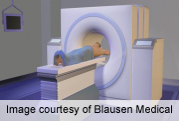
WEDNESDAY, June 6 (HealthDay News) — Children who undergo CT scans of the head may raise their risk of developing brain cancer or leukemia later in life, a new study says.
Although multiple CT scans could triple the risk, the absolute risk remains small — one case in 10,000 scans of the head, the researchers said.
“We have shown small increased risks associated with the radiation exposures from CT,” said study co-author Louise Parker, from the Canadian Cancer Society and a professor of medicine and pediatrics at Dalhousie University in Halifax, Nova Scotia.
“As long as CT is used only where justified, then the benefits of CT, a potentially lifesaving modality, will almost certainly outweigh the risks,” she said.
Lead study author Amy Berrington de Gonzalez, from the U.S. National Cancer Institute, said this study is the first to look at the actual cancer risk of radiation from CT scans.
“All the previous studies about the potential risk of CT scans have been theoretical studies using models from other radiation-exposed populations,” she said. Specifically, they studied the results of radiation exposure after atom bombs were dropped on Japan during World War II.
For the new study, researchers collected data on almost 180,000 British patients under age 22 who had CT scans between 1985 and 2002. They looked at cases of leukemia, brain tumors, how many scans were done and radiation dose absorbed by the brain and bone marrow.
Seventy-four patients developed leukemia, and 135 developed brain cancer. The researchers calculated that the relative risk for leukemia increases 0.036 for every extra milli-Gray (mGy) used, and the risk for brain tumors, 0.023 per additional mGy.
Using these data, they further calculated that one head CT scan before age 10 would result in one excess case of leukemia and one excess brain tumor per 10,000 patients in the 10 years after first exposure.
Children are more sensitive to radiation than adults, said the authors, adding that there are steps that parents can take to help limit the risk if a doctor calls for a CT scan on a child.
“Parents should talk to their health care providers and ask for the reasons for the scan, if one is recommended,” Berrington de Gonzalez said. “They can also check if CT scanners are set appropriately for the age and size of the child to ensure that the doses are optimized. If this is done, the benefits of the scan should outweigh the small cancer risk.”
The study appears in the June 7 online edition of The Lancet.
Richard Morin, chair of the American College of Radiology’s Dose Index Registry and chief medical physicist at the Mayo Clinic in Jacksonville, Fla., said this is an epidemiological study that shows an association, but not necessarily a cause-and-effect relationship.
However, “CT scans should be used wisely, and there should be a medical reason why the scan is being done and as long as there is a sufficient medical reason then the benefit far outweighs the risk with regard to radiation,” he said. “It’s not zero. However, it’s a better approach than surgery with sedation and its possible complications.”
Parents should ask their doctor if the procedure is necessary or whether there are different tests that can get the same information without radiation, such as ultrasound or an MRI, Morin said.
Parents should also keep track of the tests done and the radiation levels used so they can show doctors if their child is seen at different facilities, he said.
The American College of Radiology recommends that parents ask their child’s pediatrician or other provider who orders a scan these other questions:
- How will the scan improve my child’s care?
- Is the facility accredited by the American College of Radiology?
- Will the radiation dose be “child-sized?”
Recently, to make sure children are not exposed to more radiation than necessary when they get X-rays or CT scans, the U.S. Food and Drug Administration asked the makers of these devices to factor in the safety of pediatric patients when using existing machines and designing new ones.
If the manufacturers can’t show their equipment is safe for children, the FDA wants labels on the machines that say so.
More information
For more about imaging tests, visit the U.S. National Library of Medicine.

